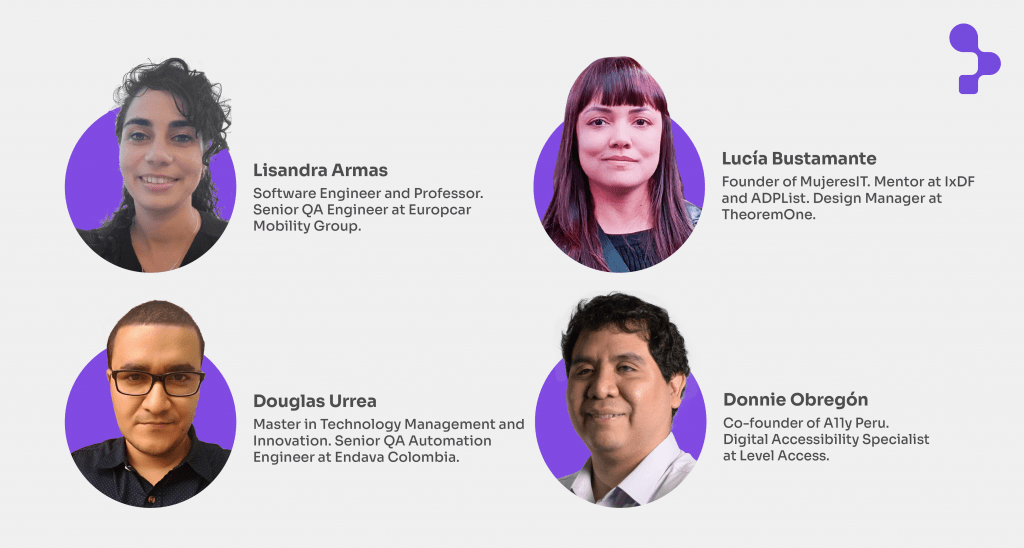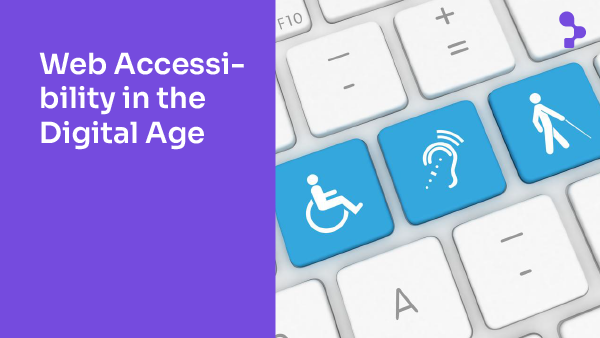The advent of disruptive technologies including Artificial Intelligence is renewing old debates about the implications of technological changes in society. At Abstracta, we have no doubt that the role of software testing is fundamental in order to work towards Digital Accessibility. A panel of experts comprising Lisandra Armas, Lucía Bustamante, Douglas Urrea Ocampo, and Donnie Obregón will share their opinions.
By Natalie Rodgers
The rapid advance of technologies is challenging our society in unimaginable ways, and rekindling old debates about their benefits and detriments. Less than half a century ago, the Italian philosopher and semiotician Umberto Eco published his book “Apocalyptic and Integrated”, which referred to different currents related to the ways of conceiving communication technologies and theories. It gave an account of an imperious debate that would accompany us indefinitely.
The birth of the cultural industry allowed the massification of access to culture and, with it, cultural goods. Along this path, we find different currents of thought. In short, according to Eco, the “integrated” are optimistic about the changes introduced by the cultural industry and the mass media, considering all this as a “broadening of the cultural field”, making cultural goods available to all people. In contrast, the apocalyptics see mass culture as “anti-culture”, are suspicious, and reject any action that could modify the order of things.
The advent of disruptive technologies including Artificial Intelligence is renewing the debate between apocalyptic and integrated, as part of the digital transformation in which our society is immersed.
At Abstracta, we believe in trade-offs: it is necessary to move forward, but never stop questioning. There is the possibility of finding a civilized dialogue between the apocalyptic and the integrated current. In which we adapt to the factual conditions in the construction of a world to human measure, without ceasing to theorize (as the apocalyptics do) on some underlying issues.
“This world, which some pretend to reject and others accept and increase, is not a world for the superman. It is also ours. It is born with the access of the subaltern classes to the enjoyment of cultural goods and with the possibility of producing the latter by means of industrial procedures,” Eco outlines in his book. And he emphasizes: “We believe that if we are to work in and for a world built to human measure, this measure will be found, not by adapting man to these de facto conditions, but from these de facto conditions”.
According to the World Health Organization (WHO), about 15% of the world’s population has some kind of disability, which is equivalent to more than one billion people. Furthermore, the agency reveals that “almost everyone is likely to experience some form of disability, temporary or permanent, at some point in their lives.” This reality, without a doubt, is a clear “condition of fact” that must be taken into account by the advancement of technologies.
We live in a globalized world in which technology mediates almost all areas of our lives. In this context, improving the digital experience of all people through the development of software without technological barriers is crucial to achieving greater digital autonomy and improving quality of life.
On this path, from a more integrated point of view, the possibilities offered by technologies, with advances such as AI, are essential to advance and work in favor of digital accessibility. But for this, from a more apocalyptic point of view, it is necessary to test ourselves and question everything constantly. In a way, software testing is the bridge for this dialogue and the key to making it a reality.
A panel of specialists in Digital Accessibility discussed the importance of software testing and Artificial Intelligence in the future of Accessibility: Lisandra Armas, from Spain; Lucía Bustamante, from Uruguay; Douglas Urrea Ocampo, from Colombia; and Donnie Obregón, from Peru.


How important is software testing in web accessibility?
Lisandra Armas: Testing is very important because it helps us to detect errors and barriers that our website or mobile application presents. Especially when we test with users with disabilities, it allows us to detect many barriers that we may have overlooked in filtering tests or automatic evaluations. It is important that we perform testing from the earliest stages of software development, starting from the requirements gathering or creation of user stories. And also to includes testing with users with disabilities, to achieve a more accessible website or mobile application.
Lucía Bustamante: The role of testing in Digital Accessibility is fundamental and critical to ensuring compliance with all Accessibility requirements according to the WCAG standard. Within usability testing in software development, there is Accessibility Testing that aims to ensure the use of the software by people with various types of visual, hearing, neurological and physical disabilities, and elderly people.
Douglas Urrea Ocampo: Commitment to the shift towards Digital Accessibility requires drive and dedication, so software testing must also advance new methods and practices in incorporating accessibility throughout the software development lifecycle. How? By incorporating accessibility testing into their processes at multiple levels, using tools to execute accessibility testing and scaling efforts with detailed and consistent documentation, in order to foster Accessibility as an ecosystem in their organizations.
Donnie Obregon: This is as key a stage as his predecessors’ Design and Development stages. It is true that the other roles involved in the development cycle, such as the designer and developer, may also have knowledge of accessibility testing and handling assistive technologies such as screen readers. But it is the testers who truly test whether the product’s functionalities respond to the ways in which people with disabilities navigate and interact when moving around and operating web content. This, of course, must go hand in hand with properly elaborated manual testing methodologies that emulate it as closely as possible.
On the other hand, a battery of tools to perform automated validations of content must be considered, as not all of them always detect the same amount or types of errors. Likewise, it should be considered which assistive technologies are most used in real life by users with disabilities because it is a priority that the tests are executed with them.
It is important to highlight that Accessibility tests must be carried out by testers trained in the WCAG 2.X standard, in the configuration and handling of assistive technologies, and in the application of appropriate validation methodologies. So, it is not enough for organizations to rely on free or paid automated tools for Accessibility Testing unless they want to put the quality of their product at risk.
What do you think will be the relevance of the Testing – AI duo in the future of Digital Accessibility?
Lucía Bustamante: This duo will be extremely crucial since the tester will have to ensure that the algorithms from which the systems will learn consider Accessibility standards. AI is already among us and everything points to it being the future of the web. So, it is and will be fundamental to consider aspects such as image recognition for the visually impaired, lip-reading recognition for the hearing impaired, subtitles, or real-time translations, among others. It will be essential to monitor how AI is learning, undoubtedly a great challenge for testing professionals.
From another point of view, AI has the ability to optimize automation testing by having the ability to repair scripts and identify patterns and relationships. The role of the tester will be critical in training the algorithms and evaluating what they learn to ensure that the tests are optimal.
Douglas Urrea Ocampo: AI will probably help testing teams to perform Accessibility testing much faster and optimal for the teams. Artificial Intelligence will help teams understand and experience different alternatives of how people with or without disabilities interact with technology and other environments through hands-on access to different assistive tools and technologies.
In our context, we can think of disability as a barrier (large or small) experienced based on auditory, cognitive, psychological, physical, body structure, speech, or visual capabilities. However, AI can help us understand much faster how accessible websites and their applications are by seeking to customize the experience to match the specific needs and patterns of a certain group of people.
AI will certainly complement testing practices where they will work closely together to make sure they are learning and implementing the most effective accessibility fixes possible.
Donnie Obregon: I believe that, in the medium future, artificial intelligence will be able to carry out the application of a large number of testing methodologies that today require human intervention, as they are beyond the reach of automated tools.
For example, currently, an automated tool is not able to discern the exceptions that apply to the contrast criteria, such as the contrast in logos of brands or organizations. In the short term, I am convinced that artificial intelligence applied to Accessibility Testing will be able to easily discriminate in these cases, allowing the tester to focus on tasks that do or do not require its participation, such as, say, checking the accuracy of an alternative text for an image.
If we can program Artificial Intelligence for different situations like the one presented above, it is clear that the tester’s role will become more oriented towards checking the usability of the experience and not just validating its Accessibility compliance.
As another example, today’s most automated tools consider the absence of a link to jump to the main content of a page as an Accessibility error. However, in terms of compliance, this criterion can be overcome by providing a correct structure of headings and HTML regions or ARIA landmarks.
It is logical to think that, in the short term, the Artificial Intelligence used in Accessibility Testing will allow contrasting a WCAG criterion against multiple techniques that achieve compliance, thus avoiding false positives and reducing test execution time, which will, in turn, allow the tester to focus on finer validations such as the usability of a flow.
Lisandra Armas: Artificial Intelligence presents great advantages and at the same time disadvantages for Digital Accessibility. An example of this can be the case of voice recognition which is very feasible for people with motor disabilities because they do not have to type a password but it would not be feasible for people who cannot speak clearly due to disability.
These situations impact Accessibility testing so in all cases where AI is involved we must apply the four principles of Accessibility: our product must be perceivable, operable, understandable, and robust. If we follow these principles, we can provide alternative ways to perceive and understand content and functionality related to the operation. And ensure that this is possible across multiple technologies and platforms, including assistive technology.
Do you agree with these contributions? We would like to hear your thoughts on the importance of software testing and AI in promoting Digital Accessibility.
Follow us on Linkedin, Twitter, and Facebook to be part of our community!
Natalie Rodgers, Content Manager at Abstracta
Related Posts
Web Accessibility Awareness in the Digital Age
Why is it important to promote awareness of the importance of Web Accessibility? What changes are coming? We consulted with a panel of experts in the field in the context of the World Web Accessibility Awareness Day. With voices from Argentina, Chile, Colombia, Cuba, Guatemala,…
[Infographic] What is Mobile Accessibility and Why is it Important?
Designing Mobile Apps with Accessibility in Mind We live in a world where mobile technology is already an invaluable part of our lives. We are able to turn to our phones for virtually anything and everything from locating the closest taco stand to calling for…








